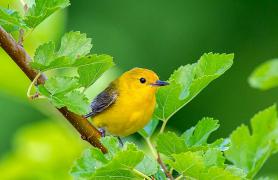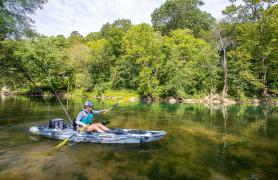
All living creatures have similar basic needs, including food, water, and shelter. A fourth need that we might not think about is space — all creatures have their personal bubble and, if crowded too closely together, can react poorly to tight quarters.
Each of these four needs in the right arrangement combines to serve as habitat, which is the place where animals live. Some animals live in forests, others in grassland, and still others in wetlands. As a natural resource agency, MDC’s job is to ensure Missouri’s wildlife has what it needs, when it needs it, and in the amount it needs. Equally important is providing Missourians access and opportunity to enjoy these critters and their habitats in such a way that no harm comes to either population.
In Missouri, 237 birds, 46 amphibians, 33 reptiles, 38 fish, and 34 mammals depend on wetlands, and many other species, like deer, make periodic use of wetlands. So how do we ensure that sufficient wetland habitat for all these species is available when Missouri has lost about 87 percent of wetlands that once existed in the state? And, equally important, how do we ensure our actions are strategic so that our approach is focused and efficient rather than hit-or-miss?
Focusing on Wetland Conservation
This is the second article of three highlighting a series of assessments that are the first steps in implementing MDC’s Wetland Planning Initiative. The initiative is guided by a strategic guidance document, which articulates our philosophy on how we plan to approach wetland conservation in the next 25 years, and an implementation plan, which serves as an invitation to partners and stakeholders to engage with us in wetland conservation.
Before pursuing these goals, we must first understand what changes have occurred, our status, and future opportunities. We have conducted three assessments to provide this understanding: a bottomland functional assessment, a life history assessment of wetland-dependent animals, and a social assessment. This article highlights some of this important work encompassed in the life history assessment of wetland-dependent animals. The first article, Meaningful Connections, was published in the February 2022 issue of Missouri Conservationist.
Taking Inventory
An assessment, or inventory, is a good first step, as it enables us to take stock of what wetlands we once had in Missouri, determine what we have now, and figure out what is realistic to accomplish for the future. To determine the kinds and amount of wetlands we once had in Missouri, we assessed wetlands on all bottomland ecosystems in Missouri (see the article, Meaningful Connections, in the February 2022 Missouri Conservationist).
Next, we need to know how well these habitats provide for the needs of animals that depend on wetlands. And to do this, we first identified the key ecological processes and landscape settings that drive wetland conditions. The dynamic nature of wetlands is what makes them so productive. Conditions change seasonally based on how long a wetland is inundated with water, how frequently they flood, and the resulting vegetation. Wetlands hold water for different lengths of time (inundation duration) ranging from permanent (year-round) to semi-permanent (dry up periodically) to seasonal (four to nine months) to ephemeral (less than 90 days). Some wetlands are connected to rivers or streams and flood frequently, whereas others are more isolated, located further toward river bluffs and only flood occasionally, if ever (inundation frequency).
The vegetation, or landcover, that occurs at the intersection of inundation duration and frequency will vary depending on how well plants are adapted to tolerating wet conditions and may range from mudflats (little to no vegetation) to herbaceous plants (annual moist soil vegetation plants such as smartweed and wild millet) to robust emergent vegetation (cattails, bulrush, bur reed), to forest (mixed oaks and other trees). Different plants and animals are adapted to these different conditions and, although animal species may occupy similar habitats, they typically exploit them differently in ways that reduce competition, such as ducks or shorebirds that feed at different water depths, or use them at different times of the year.
A Model Approach
To assess how well wetland conditions match up with wildlife needs, we decided to take a modelling approach. Since we could not develop models for each of nearly 400 wetland-dependent species, we instead chose surrogate species whose habitat needs represent the unique combination of conditions that occur in wetlands. We wanted a mix of species that use wetlands in different ways and at different times of the year, so we were sure to cover the full range of wetland types and animal needs. We chose paddlefish as a surrogate of riverine species that use permanent water but need wetlands as nursery locations, meaning their critical wetland need occurs in late spring through summer. Least bitterns represent breeding waterbirds that use semi-permanent wetlands that only dry up periodically and typically have robust emergent plants as the dominant vegetation and are critical for bitterns’ successful nesting efforts. Small-mouthed salamanders depend on seasonal wetlands for breeding and larval development and are much less mobile than a bird or fish, so they require smaller wetland areas that include connectivity to forest where they spend about 10 months out of the year. Gray treefrogs represent wetlands located near river bluffs or embedded within upland forests that are less frequently flooded than a wetland located near rivers or streams. Mallards, soras, and pectoral sandpipers all represent migratory species but require different landcover categories, including herbaceous annual vegetation, robust emergent vegetation, and mudflats, respectively. Prothonotary warblers represent breeding interior forest species dependent on bottomland forest.
Once we selected our surrogate species, we wanted an approach that included a spatial element (where did suitable wetlands occur), a predictive element (what are the chances a species would use a wetland), and that quantified the degree of uncertainty associated with our predictions. The amount of uncertainty or unknowns is a major challenge when trying to model ecological systems because there are many factors for which we do not have control, such as weather and habitat features. For example, although we know least bitterns nest in wetlands with robust, emergent vegetation like cattails that have water throughout the nesting season, how does the relationship of vegetation to water contribute toward successful nesting? Is it a Goldilocks-type relationship in that there can be too much vegetation (100 percent canopy coverage), too little vegetation (100 percent open water), or the “just right” mix of vegetation to water (50 percent water to 50 percent vegetation)? And, if there is a “just right” mix, what is it and how do we measure it? And how do wetland management decisions influence the mix of vegetation to water and, potentially, nesting success?
This is BBN
The modelling approach we selected is called a Bayesian Belief Network (BBN), where “belief” acknowledges that these models incorporate how we think the system being modelled works. BBNs are graphic models that can be used to explore the probability or chance that some outcome — which in our models is animal presence — will occur based on relationships between environmental or ecological factors that, together, form suitable habitat conditions for the animal. We built our models to incorporate time and space so we could accommodate variation among the different species’ life history needs. We broke the time component down by two-week intervals to account for the different times that critical needs occur for each species. We included a regional sub-model that calculates the probability that an animal will find or encounter a wetland complex and find it suitable; this is somewhat comparable to finding a neighborhood that suits its needs for a specific time of year. The second sub-model occurs at the individual wetland scale and calculates the probability an animal will find what it needs within a wetland whether it be nesting habitat for a breeding species or foraging habitat for a migrating species. The final output of the model is the probability that a site is occupied by the species.
We constructed models for each surrogate species based on information gleaned from an extensive review of almost 10,500 scientific articles and by incorporating the knowledge of 54 experts, including researchers and wetland managers with extensive experience with at least one of our surrogate species. We also used geographic information layers to build a wetland spatial layer that helps inform species model attributes or characteristics (e.g. number of wetlands, landscape habitat composition, wetland area), especially at the complex scale, that contribute toward predicting if habitat conditions are suitable for each of the surrogate species.
By using the experiences and knowledge of species experts to fill in information gaps, we can calculate probability estimates that predict the chance an animal will find and use a wetland and quantify uncertainty of that estimate. Uncertainty is reduced when species experts agreed on some parts of the model; for instance, there is general agreement that in areas with a lot of wetlands, emergent marsh habitat (cattails), and large wetlands, we will find least bittern. But other scenarios may have less agreement among species experts, such as a complex that includes many wetlands, but the dominant wetland type is woody wetlands, and wetlands are smaller, which can result in greater uncertainty. In this instance, the chance of least bittern presence is likely much less, but we are not as sure of our estimate because there is a lack of information on whether or if least bittern use woody wetlands. Over time, as we validate our models and learn more based on actual data, we can update the models. This is especially powerful in a decision support framework in which we can learn from our management decisions.
Finding a suitable complex is somewhat akin to finding a neighborhood that has the features a species needs. Although wetlands are the common denominator across our surrogate species, specific needs of each species will vary depending on time of year and whether they are migrating, nesting or raising young. This map depicts a wetland complex from a breeding least bittern’s perspective. Factors that influence if it is suitable include size and arrangement of wetlands, density or number of wetlands, and percent of different land cover within the complex (agriculture, forest, wetlands).
Aiding Future Planners
Some early outcomes from this project include maps that predict the habitat suitability at two spatial scales (landscape and local) while also producing estimates of model uncertainty. As species models are further developed, we will generate habitat suitability maps during different times of the year, thereby establishing a baseline framework to overlay the various layers of habitat suitability for local populations. Ultimately, this information can be used by wetland conservation planners to set local population objectives. Assessment information will also enable these local decisions to be integrated into statewide strategic goals and objectives, as well as larger planning efforts at regional and national scales. Once established, the models can continue to be refined, assisting in our ability to conserve wetlands in a manner that meets the basic needs of a range of wetland-dependent species.






























Also In This Issue

With spring migration at its peak, there’s no better time to join America’s growing flock of birders.

Closer to the water, connected to nature.
And More...
This Issue's Staff
Editor - Angie Daly Morfeld
Associate Editor - Larry Archer
Photography Editor - Cliff White
Staff Writer - Kristie Hilgedick
Staff Writer - Joe Jerek
Staff Writer – Dianne Van Dien
Designer - Shawn Carey
Designer - Marci Porter
Photographer - Noppadol Paothong
Photographer - David Stonner
Circulation - Laura Scheuler






















